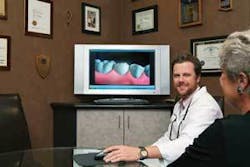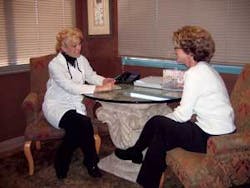Technology and the new-patient experience
Over the past 30 years, Briggs Family Dentistry has taken on the challenge of keeping up with technology as our practice has expanded and new options became available for treating patients more efficiently and effectively. When we finally decided to build a brand new facility, we spent about two-and-a-half years bringing ideas to staff meetings and working as a team to design a practice that would best fit our needs. Our planning paid off in August 2004 and, fortunately, it has really been an easy transition for our staff.
The new office is very spacious. We created a layout which efficiently integrates technology throughout the entire design. Our office continues to use Patterson EagleSoft clinical and practice-management software, the CAESY patient-education system, CEREC technology, Reveal and Schick intraoral cameras, and the Waterlase®, dLase 300 and Laser Smile™ lasers, which are all good instruments for use in a perio program. We have introduced Schick digital radiography in each of our four dental operatories and four hygiene operatories. We also recently installed panoramic digital-radiography equipment for full-mouth digital panoramic reconstruction. This article will describe our unique approach to comprehensive patient care, utilizing technology to educate and create a unique experience for each of our patients, from start to finish.
The new-patient experience
The new-patient experience begins with an in-depth interview over the phone. It is during this time that we focus on stimulating interest while gathering data. When patients call in for an appointment, our greeter conducts a brief telephone interview consisting of a series of questions regarding their experiences, expectations, and concerns. We learn a little about them and begin to develop rapport over the phone. As a result, we know if patients are interested in cosmetic dentistry, if they have a referring doctor, and how we can go about making them feel comfortable when they come in for their initial appointment.
Based on this information, we can call the patient’s previous dentist to request any X-rays or records on file and integrate this information into our electronic records before the patient’s first visit. As a follow-up to the phone interview, we also send each patient a nice folder with paperwork in preparation for his or her visit, including a health-history form, questions about changing appearance, and more. This provides the staff with a comfortable way to broach specific topics during conversation. Because new patients complete the forms prior to their visit, they already have started thinking about what procedures they might want before they come into the office.
The night before every new patient’s appointment, the doctors call to see if the patient has any specific concerns that need to be addressed the next day. This also reinforces the importance of the time that has been reserved for the patient.
Once patients arrive at the office for their initial visit, they are welcomed by the greeter. The greeter talks with them and answers any questions before seating them in our beautiful reception area. The waiting room features leather chairs, a recliner, a large colorful rug, and a 42- inch plasma television that broadcasts the news or shows a CAESY patient-education video. We also stock a refrigerator with beverages and plenty of new magazines are available for them to choose from. Using the “OnSchedule” feature in Patterson EagleSoft, the greeter will then send an Instant Message to notify the assistant that the patient has arrived for his or her new-patient experience. A yellow light in the patient’s electronic appointment record indicates the patient is ready. This light changes to green once the patient has been seated.
Patients and our new-patient coordinator (who is also one of our hygienists) meet for the first time in a beautiful, comfortable room with two wing chairs. We purposely strive for a nondental environment, which serves to foster communication. The new-patient coordinator discusses the patient’s health using an interview process we call the “B-A-G Approach” - where they have “Been,” where they “Are” today, as well as their expectations and, finally, where they would like to “Go.” At this point in the conversation, the setting shifts next door to an operatory for charting periodontal and existing problems and preparation for what to expect from the doctor during the exam.
The doctor and new-patient coordinator work together as a team to conduct comprehensive periodontal exams. We do not, however, use voice recognition, because we want our patients to hear the numbers from us. We feel this has more of an impact. We provide each patient with an oral cancer screening using new ViziLite® technology, and then proceed to the clinical exam. We utilize Schick digital radiography to collect a series of 16 images for every patient. These images create a lot of value during treatment planning and are excellent to refer to during treatment.
We record a series of six to eight different digital photographs with our intraoral camera, collecting various angles to examine the relationships, as well as the cosmetics of the teeth. These images help patients envision what their teeth will look like following treatment. We also show them to the patient on a large flat-screen monitor during the treatment conference. Finally, the doctor uses a DIAGNOdent laser light to detect caries as a part of every clinical exam.
All of the charting and images from the clinical exam are included in the patient’s record. The ability to integrate all of this information into a single record is incredibly efficient and very helpful during our comprehensive treatment planning. With one patient record, we can converse with patients about their case and educate them by pulling images or documents relative to their treatment.
Treatment planning
We generally see two to three new patients each day, for two hours each. For each of these patients, our team - consisting of the treatment coordinator, assistant treatment coordinator, four hygienists (including the new-patient coordinator), and two doctors - meets every Thursday morning for treatment planning. During this session, we examine each case, along with any charts, scans, and study models which have been prepared. The new-patient coordinator serves as the voice of the patient in these meetings, and conveys any information gathered from her conversation with the patient, including the patient’s fears, finances, personality, wants, interests, and more. The first hour spent on treatment planning makes all the difference in how much more informed our staff can be, and it is one of the most important factors that makes our practice a success. We find that when we sit down with the whole team to do comprehensive treatment planning, it results in a learning experience for everyone.
The treatment coordinator takes notes during this discussion, and then inputs the treatment plan recommendations into the patient record in EagleSoft. We have a strong focus on patient education and bringing the information together in a way that the patient can understand. The treatment coordinator then prepares a complete summary of the patient’s treatment plan, creates any corresponding CAESY patient-education CDs, establishes an appointment plan, and works out financial arrangements before a treatment conference is held with the patient.
Treatment conference
After hearing about their conditions and walking out of the new-patient experience, patients often try to solve the conditions themselves (we have not offered any solutions at this point). One week later, we invite new patients to return to the office, while they still feel a sense of urgency about their treatment needs. However, we also conduct treatment conferences with patients who have no problems in their mouths. In these cases, we explain the good things that have happened in the past and how they impacted their present condition. This also is an opportunity to discuss any potential problems that could occur over the next 10 to 20 years, which gives patients a look into the future of their oral health.
When patients arrive for their treatment conference, the treatment coordinator escorts them into a beautiful conference room, where the doctor is waiting at a round table. The patient is seated between the doctor and the treatment coordinator, facing a 30-inch flat screen, high-definition monitor. The doctor typically sits next to the patient during his presentation, utilizing CAESY demonstrations and constantly pulling up the patient’s photographs - both intraoral and extraoral - and all digital X-rays in the EagleSoft patient record. With this, we can visually show patients their condition and help them learn about their treatment options. The doctor often uses the mouse to point out things on screen.
We do not push cosmetic dentistry, and we certainly do not push veneers on everyone who walks in the door. Rather, we utilize our technology to help our patients experience the problems in their teeth for themselves. We emphasize that they should be the ones to decide exactly what they want. Simply presenting conditions and treatment options is a very powerful tool. Utilizing all of the advanced teaching tools in our practice enables us to become more like coaches, not sales organizations, for our patients. They do not feel pressured that we’re trying to sell them something. At this point in the experience, the patients begin asking us for treatment because we have helped them understand the science behind their health and esthetics. By the time the doctor completes his presentation, any “selling” is already done.
It is very important to listen carefully to your patients. Patients can easily become overwhelmed, especially with a large case, so it is important to take the time to read each individual patient’s reactions while the doctor explains the treatment plan. The treatment coordinator will address any special concerns or needs, whether that’s helping to coordinate a referral to a specialist or helping with insurance questions. We operate an insurance-free practice by maintaining flexibility and utilizing the best benefit for each patient, even if this means breaking up treatment over several years to maximize benefits.
When patients leave the treatment conference, they know what they want and what they can do financially. We present each patient with a black folder that contains all of their information, including fees and financial options, but there is no hard sell. The treatment coordinator also will include a CAESY ShowCase take-home disk, copy of the perio chart, probing record, and any images that the patient might wish to review. If the patient has not made an appointment before leaving, we will give him or her 30 days before conducting a follow-up phone call.
Create an educational experience
Although it may sound counter intuitive, we have found that when we slow down to create an educational experience for our patients, we produce more. Setting aside quality time up-front to really understand patients and produce comprehensive treatment plans simply leads to higher patient acceptance of comprehensive dentistry.
We strive to build relationships, understand behavioral styles, and address confrontation issues. In addition, we work to create a fully engaged, trained team which is equipped with the latest technology to provide comprehensive exams and quality presentations. The result is happier patients who invite their family and friends to experience our superior level of service.
Editor’s Note: Drs. Roger and Brad Briggs wish to acknowledge the contributions of their staff members to this article.
Drs. Roger and Brad Briggs operate a general practice with a strong focus on family and cosmetic dentistry in Scottsdale, Ariz. Their team includes four hygienists, three chairside assistants, a greeter, and two business office staff assistants. With more than 34 years of combined experience, both father and son are graduates of Loma Linda University School of Dentistry and members of the ADA and AACD. The authors can be reached by phone at (480) 948-7670, or by e-mail at [email protected].


